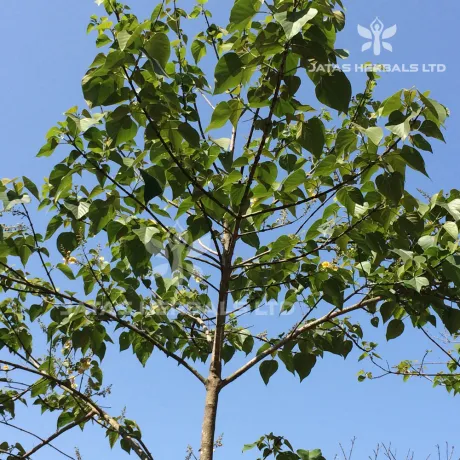It will be interesting to note that the term Gambhari used routinely now for Kasmari was not mentioned in Brihat Trayi. However, other synonyms like Sriparni and Sadabhadra are used by them. Gambhari is the term actually used by tribal people of Bihar. It is a good example, now vernacular names become popular as classical names. Even the synonym ‘Sadabhadra’ is quoted by Sushruta in one contenxt only (S.S.Ut. 24/32).
Caraka quoted its fruit as best among Rakta-Sangrahaka and Raktapittahara (C.S.Su. 25). Its fruit is one among the ‘Madhura Triphala (three sweet fruits). Gambhari fruit is considered as a substitute for Draksha (grapes). It is Brimhana, Vrshya and Rasayana in nature. The root bark how ever is included in the Sothahara group and Brihat Panchamula group by Caraka and Sushruta respectively. Kaiyadeva described its flowers as Sangrahi and Vatavardhaka.
Botanical Description– A large deciduous tree, 20 m high. Leaves– large, tomentose underneath, cordate-ovate, acuminate. Flowers– yellow, tinged with brown, in terminal and axillary racemiform panicles, composed of lateral cymes. Fruits– drupes, yellow when ripe. Seeds– oblong. Flowering in February-April & fruiting in April-July. Distribution– Found throughout Deccan Peninsula.
Major Chemical Constituents–
β-sitosterol, ceryl alcohol, gmelinol; butyric & tartaric acids; apigenin, premnazole, arborone, arboreol, isoarboreol, cutytyl ferulate, epieudesmin, gmelanore, gmelafuran, gummadiol, non-saponifiable fraction, saponifiable fraction, apiosyl-skimmin, octacosanol etc.
Part Used– Root, fruit, flower, leaves
Dosage– Root bark decoction 50-100 ml, fruit powder 1-3 g.
Research–
(1) The alcoholic extracts of the stem bark and wood of the stem were found to possess hypoglycaemic activity in albino rats. The stem bark extract also showed anti-viral activity against Ranikhet disease virus (Dhar et al., 1968).
(2) The Rasayana (anabolic) effect of the fruits was studied in rabbits using electrophoretic analysis of serum fractions, body weight and physical behaviour as parameters. An increase in the percentage of 2 and -globulin fractions, gain in body weight and alertness in physical behaviour was observed after treatment (Gaur & Gupta, 1968).
(3) Premnazole showed anti-inflammatory activity comparable to that of phenylbutazone in reducing cotton pellet-induced granuloma formation in rats. It probably acts by regulating activity of ACTH (Fitoterapia 1992, 63, 295).




Reviews
There are no reviews yet.